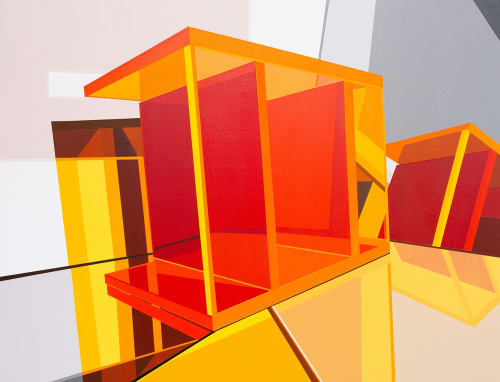Inman Gallery is pleased to present Tommy Fitzpatrick: Factual Facts and Actual Facts, opening Friday, June 1, 2018, with a reception from 6 to 8 pm, and continue through July 7, 2018.
Containers or structures split apart and fracture, their walls resting on each other, mirroring themselves, and angling into the suggestion of other spaces in Tommy Fitzpatrick's newest paintings. At once citing architectural forms—the paintings are called Aedicule, Bascule, Monolith, Pavilion— and invoking the entrance of the figure, Fitzpatrick teases our sureness of where we are, what we know, and how we see. What happens if the walls our senses try to describe become transparent, reflective, or unstable? Looking to Josef Albers's lectures on color and perception, Fitzpatrick alludes to a contemporary moment in which even seemingly stable knowledge is called into question. "In visual perception a color is almost never seen as it really is — as it physically is," Albers writes in his 1963 experimental guide Interaction of Color, "In order to use color effectively it is necessary to recognize that color deceives continually."
In Pavilion, Fitzpatrick's shades of pink, salmon, red, and
peach create a window-like rectangular form, against which
leans a panel that seems to reflect a two-shelved Plexi
display case, its shelves with tones of teal, gray, green, and
crimsony-pink. The seemingly dual-tone palette of the
canvas is infinitely complex, its surfaces and assumptions
shimmering into unreliability. In Box Frame, Fitzpatrick's choice of an orange and yellow color spectrum paired with grays, whites, and blacks construct not only a mysterious form, but also a complex relationship to the composition's space. Surfaces seem to move in and out of each other, any solidity dissolving into reflection.
What is factual and what is actually fact? In this case, the factual, Fitzpatrick says, are the Plexiglas maquettes he constructs to develop the painting's composition. And the actual facts are the paintings themselves, an endlessly dynamic and yet often indecipherable series of seemingly transparent forms. Sight and perception are at the root of the artist's investigations, and he pushes toward a kind of insoluble discrepancy between the two. Indeed, he wants to cause an experience of visual doubt. It's an experience one also often finds in contemporary political discourse: think you know something and the palace of mirrors shifts and shimmers into something else, a visual quicksand in which meaning is unclear and structure is indescribable. "In my paintings, a structural solution is offered to the spectator—yet, even while one is still looking, even before the solution can be comprehended, it has already been put in question," Fitzpatrick writes.

